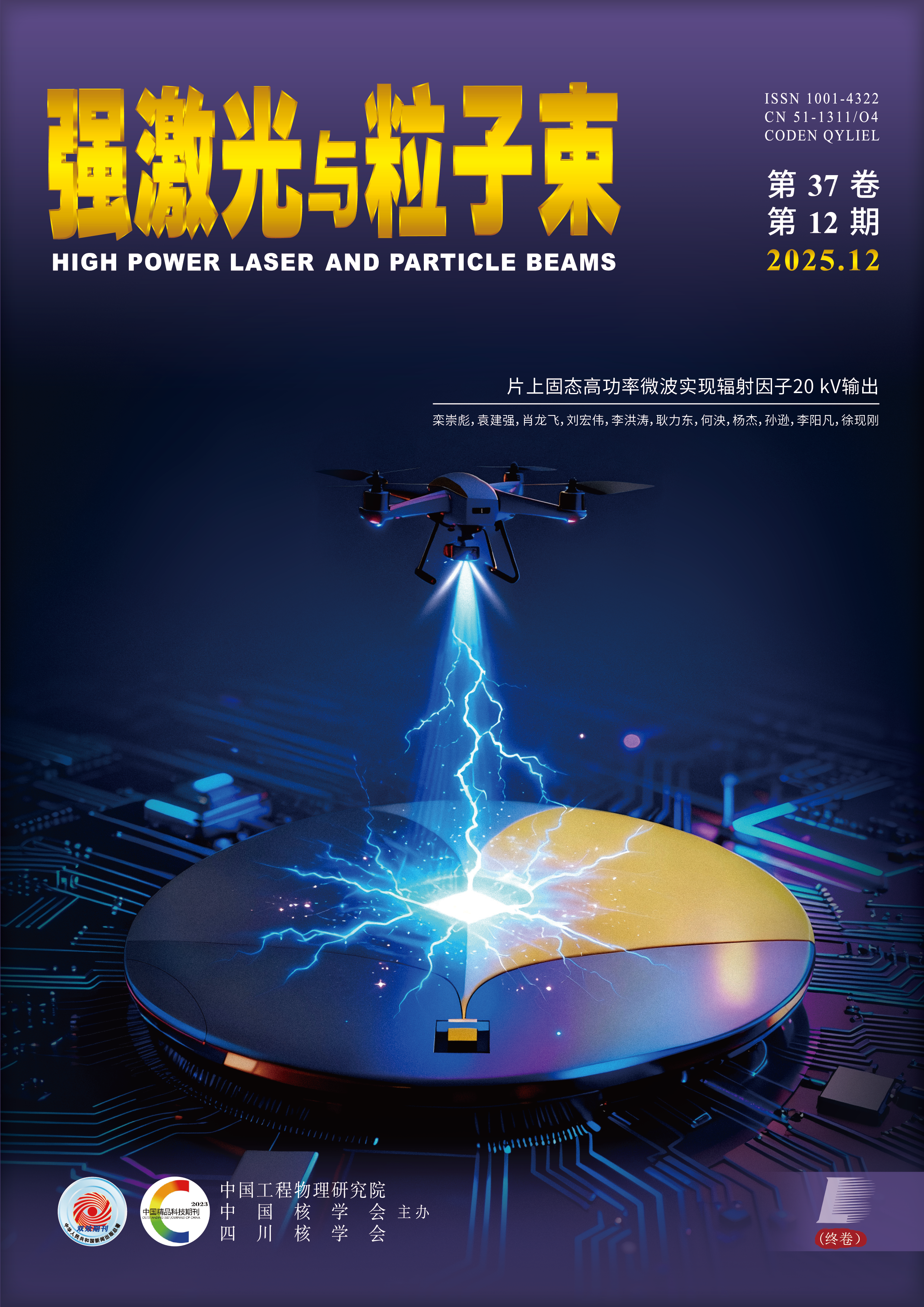Latest Articles
Articles in press have been peer-reviewed and accepted, which are not yet assigned to volumes/issues, but are citable by Digital Object Identifier (DOI).
Display Method:
, Available online , doi: 10.11884/HPLPB202638.250251
Abstract:
Background Purpose Methods Results Conclusions
Fiber lasers have gained extensive adoption across medical, telecommunications, industrial processing, and defense sectors owing to their exceptional beam quality, operational stability, compact architecture, and high reliability. Among them, narrow-linewidth linearly polarized fiber lasers have become a key research focus due to their outstanding spectral purity and coherence, with current efforts concentrated on further scaling their output power and brightness.
In this work, we demonstrate a 5.09 kW narrow-linewidth linearly polarized fiber laser system designed to overcome stimulated Brillouin scattering (SBS) and transverse mode instability (TMI).
A white-noise radio frequency phase modulation scheme is implemented to broaden the seed laser spectrum into a Gaussian profile with an 89 GHz full width at half maximum, enabling effective SBS suppression. A polarization-maintaining ytterbium-doped fiber (PMYDF) with low numerical aperture (about 0.05), large mode area (about 237 μm2), and high birefringence coefficient (4.23×10−4) is employed to simultaneously mitigate SBS and intermodal thermal coupling.
The system achieves 5.09 kW output power while maintaining an 89 GHz spectral linewidth, polarization extinction ratio above 19.6 dB, and beam quality factor of M2 < 1.2. No self-pulsing or temporal instability is observed at maximum power, confirming suppression of both SBS and TMI.
By employing a white-noise radio frequency signal to modulate the phase of a single-frequency laser, the SBS effect in high-power fiber laser systems is effectively suppressed. Concurrently, intermodal thermal coupling and SBS are further mitigated using a fabricated low-numerical-aperture, large-mode-area PMYDF. The demonstrated performance supports the feasibility of high-power, narrow-linewidth polarized fiber lasers for long-term stable operation.
, Available online , doi: 10.11884/HPLPB202638.250243
Abstract:
Background Purpose Methods Results Conclusions
The traditional Monte-Carlo (MC) method faces an inherent trade-off between geometric modeling accuracy and computational efficiency when addressing real-world irregular terrain modeling.
This paper proposes a fast MC particle transport modeling method based on irregular triangular networks for complex terrains, addressing the technical challenge of achieving adaptive and efficient MC modeling under high-resolution complex terrain scenarios.
The methodology consists of three key phases: First, high-resolution raster-format terrain elevation data are processed through two-dimensional wavelet transformation to precisely identify abrupt terrain variations and extract significant elevation points. Subsequently, the Delaunay triangulation algorithm is employed to construct TIN-structured terrain models from discrete point sets. Finally, the MCNP code’s “arbitrary polyhedron” macrobody definition is leveraged to establish geometric planes, with Boolean operations applied to synthesize intricate geometric entities, thereby realizing rapid automated MC modeling for high-resolution complex terrains.
The results demonstrate that the proposed method accurately reproduces terrain-induced effects on radiation transport, achieving high-fidelity simulations while significantly compressing the number of cells and enhancing computational efficiency.
This methodology represents a novel approach for large-scale radiation field modeling under complex terrain constraints, demonstrating broad applicability to MC particle transport simulations in arbitrary large-scale complex terrain scenarios.
, Available online , doi: 10.11884/HPLPB202638.250155
Abstract:
Background Purpose Methods Results Conclusions
Currently, the bias power supplies in high-voltage electron beam welders, both domestically and internationally, are suspended at a negative high voltage. The output voltage regulation is achieved by sampling the operating current in the high-voltage power circuit. The sampled current signal undergoes multi-stage conversion before being sent to the bias power supply, which then adjusts its output voltage based on the feedback current. This adjusted output voltage, in turn, alters the current in the high-voltage circuit. Since the bias power supply is an inverter-based power source, its response and adjustment cycles are relatively long, and precise step-wise regulation is challenging. Consequently, this leads to significant beam current ripple, poor stability, and inadequate beam current reproducibility, failing to meet the requirements of precision welding for beam current stability and low fluctuation.
This paper aims to develop a bias power supply with an adjustable DC output voltage ranging from −100 V to −2 kV, featuring low voltage ripple and high voltage stability. The bias power supply can be connected in series within the high-voltage circuit, enabling rapid adjustment and precise control of the operating beam current through a fast closed-loop feedback control system. Additionally, the bias power supply must operate reliably during load arcing of the electron gun.
The design incorporates absorption and protection methods to address the issue of electron gun load arcing damaging the bias power supply. By connecting the bias power supply in series within the high-voltage circuit and feeding back the operating current in the bias power supply loop, the output voltage (bias cup voltage) is adjusted. The bias cup voltage adaptively regulates according to the beam current magnitude, achieving real-time rapid tracking and fine control of the operating beam current.
A bias power supply was developed with an adjustable DC output voltage from −100 V to −2 kV, featuring a ripple voltage of ≤0.1% across the entire voltage range, voltage stability better than 0.1%, and an output current greater than 3 mA. When applied to a −150 kV/33 mA high-voltage electron beam welder, it achieved a beam current ripple of ±0.19%, beam current stability better than ±5 μA, and beam current reproducibility of ±0.04%.
Based on the methods of absorption, protection, and adaptive regulation of the bias cup voltage according to the beam current magnitude, a novel bias power supply for high-voltage electron beam welders has been successfully developed. This solution addresses the issues of large beam current ripple, poor stability, and inadequate reproducibility in high-voltage electron beam welding, providing an effective approach for high-stability, precision-controllable welding.
, Available online , doi: 10.11884/HPLPB202638.250181
Abstract:
Background Purpose Methods Results Conclusions
The surface flashover in SF6 under nanosecond pulses involves complex physical processes, and accurately predicting the surface flashover voltage of insulating media in such environments constitutes a critical challenge for the design of high-voltage pulsed power equipment and the evaluation of insulation reliability. Compared with traditional AC or DC voltages, the extremely short rise time and high amplitude of nanosecond pulses lead to significant space charge effects and distinct discharge development mechanisms, thereby posing severe challenges to prediction models based on classical theories. In recent years, with the rapid improvement of computer computing power and breakthroughs in artificial intelligence algorithms, data-driven machine learning methods have demonstrated great potential in solving complex nonlinear insulation problems.
Targeting this specific challenge under nanosecond pulses, this paper selects four algorithms, including support vector machine (SVM), multi-layer perceptron (MLP), random forest (RF), and extreme gradient boosting (XGBoost), to train and predict flashover voltage data under different experimental conditions within the multi-scale distance range of 15 mm to 500 mm.
First, external operating conditions such as electric field distribution, voltage waveform, and gas pressure were parametrically extracted and characterized. The Pearson correlation coefficient was employed to conduct a correlation analysis on the aforementioned characteristic parameters, and ultimately 22 feature quantities were screened out as the model inputs. Subsequently, the Bayesian hyperparameter optimization algorithm was utilized to perform hyperparameter optimization for four types of algorithms, and the 10-fold cross-validation method was adopted to select the optimal hyperparameter combination for each algorithm. After that, the sample training set was input into the four algorithms for training, and each algorithm was validated on the test set.
The four algorithms demonstrated overall good performance. Among them, random forest (RF) and XGBoost exhibited excellent performance on the training set but poor performance on the validation set, which is likely a manifestation of overfitting in ensemble learning and indicates weak generalization ability. support vector machine (SVM) achieved relatively outstanding performance on both the training set and the validation set. Furthermore, the generalization performance of the SVM and XGBoost algorithms was validated using data outside the sample dataset. The results showed that SVM yielded better prediction outcomes on the data outside the sample dataset.
SVM achieved high prediction accuracy on the training set, test set, and data outside the sample dataset, making it more suitable for the insulation design of electromagnetic pulse simulation devices.
, Available online , doi: 10.11884/HPLPB202638.250257
Abstract:
Background Purpose Methods Results Conclusions
Space solar arrays, as a crucial part of satellite power systems, are essential for maintaining normal satellite operation. Their large surface area and complex insulation structure make them highly vulnerable to strong external electromagnetic fields. High-power microwaves (HPM), with their wide bandwidth, high power, and rapid action, can readily damage such structures. Therefore, investigating the HPM coupling effects on space solar arrays is of significant importance.
This study aims to investigate the electric field coupling of space solar cell array samples under high-power microwave exposure.
Using a representative solar cell array structure and layout as a reference, we construct a three-dimensional model under high-power microwave irradiation and examines the coupling behavior of the array under varying excitation source parameters, including frequency, polarization direction, incidence angle and so on.
(1)Within the frequency range of 2–18 GHz, vertically polarized S-band microwave irradiation is most likely to induce discharge damage to the solar cell array, with the induced electric field at the triple junction in cell string gaps being much higher than that at interconnect gaps. (2) Under microwave irradiation, the solar cell samples exhibit intense transient electric fields; in the case of vertical polarization, the induced field is mainly concentrated in the cell string gaps, near the busbars, and along the cell edges. (3) The steady peak of the induced electric field at the triple junction decreases with increasing microwave incidence angle and increases with higher microwave power density. (4) The rise and fall times of the microwave pulse have no significant effect on the induced electric field magnitude. (5) The electric field in the space around the cell string gap gradually decreases from the gap center toward the outer region.
The findings of this study provide valuable references for the electromagnetic protection design of space solar cell arrays.



 Email alert
Email alert RSS
RSS
